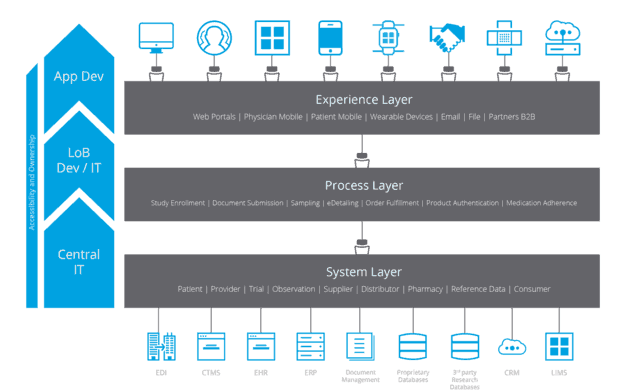Drug prices for Americans under 65 are projected to rise more than 11% in 2017. For consumers and health insurance companies, this is a real challenge as prescription drugs account for 10% of all healthcare spending in the United States. In an increasingly competitive landscape, where consumers can compare and choose cheaper drugs and where insurers want to pay less, pharmaceutical companies are feeling pressure to drive down costs.
IT is at the center of many initiatives designed to reduce the cost of developing and bringing new drugs to market, enabling these companies to address downward price pressures. Connectivity between systems, data, and devices plays a vital role in many of these initiatives, and for organizations to successfully execute on these them without an increase in IT budget or resource, a faster approach to connectivity centered around APIs (Application Programming Interfaces) is needed.
Where IT can help reduce healthcare costs
Increasing new product development speed
While new product expansion represents a continual growth opportunity for pharmaceutical companies, doing so in a cost-effective manner has grown in difficulty. A study commissioned by the Tufts Center for the Study of Drug Development observed that, “over the past 10 years, per-drug R&D costs have increased at an average of 8.5% per year above inflation.”
Increases in both the sophistication of new drugs, as well as increasing regulatory challenges, continue to push development costs higher. As a result, the estimated average out-of-pocket R&D cost per approved new compound has increased to $2.87 billion dollars.
As drug and device development grows in complexity and cost, IT has been called upon to streamline core business processes and enable reuse with the goal of accelerating product development speed and reducing costs. The goal is that improved business processes could offset the rising costs of R&D.
Supporting value-based care
The transition from a fee-for-service to value-based care model (that is, being paid based on the quality, not the quantity, of healthcare services delivered), which has traditionally been discussed within the context of the hospital or health system, has similar impacts for pharmaceutical companies.
IT innovation provides a means for pharmaceutical companies to address this new paradigm. By accessing, orchestrating, and analyzing data from institutions that prescribe their drugs, they can provide hard evidence of the clinical impact of their products, and use that to justify reimbursement from insurers.
Streamlining manufacturing and distribution
Pharmaceutical companies must continually invest in maintaining the integrity of products as they traverse the supply chain, from contract drug manufacturers, to wholesalers, to distributors, patients. As the number of countries in which they seek to do business grows, so does the number of points across the supply chain that must be managed. This, in turn, has increased global go-to-market costs.
Interfacing across this growing number of distributors and wholesalers has taxed organizations’ IT teams that have typically relied on point-to-point EDI interfaces. In order to successfully enable new market development, pharmaceutical companies must identify a means through which they can standardize common business processes across different geographies, such as supply chain partner reporting, or physician portal development, while accommodating the unique regulatory requirements across each of these geographies.
Driving digital engagement with clinicians
The number of ways doctors interact with pharmaceutical companies has increased in recent years; today, these companies with healthcare providers via sales rep visits, email marketing, telesales, direct mailings, speaker programs, self-serve web portal content, mobile apps and alerts, EHR connectivity, and more. With so much noise, drug companies must work harder to provide personalized, pervasive engagement with clinicians across an increasing number of channels. This requires IT to deliver a growing number of projects to support engagement across these channels.
Status quo integration approaches (e.g. point-to-point connectivity) hinder the organization’s capacity to bring these channels online fast enough to keep up with competitors. A new approach is required — a holistic, strategic approach to integration centered around consumable, reusable APIs — called API-led connectivity.
How API-led connectivity can cut costs at pharmaceutical companies
APIs provide a means of circumventing the problems created by point-to-point integration, and establish a foundation for driving asset re-use within the enterprise, increasing IT productivity and enabling them to meet the demands of the business. API-led connectivity provides a means of leveraging APIs so that the benefits of reuse and increased governance can be realized. It calls for a modular, composable architecture of System, Process, and Experience APIs that decouple exposing data from core systems, from orchestrating that data into units of business value, to exposing that data in a format or experience that best suits the end consuming user or application.

This layered model of System, Process, and Experience APIs incorporates governance, security, and visibility, while allowing flexibility as business needs evolve. This could include moving from a legacy on-premises product info database to a cloud solution, or incorporating more and different systems after acquiring another industry player or product pipeline.
API-led connectivity’s flexibility applies to front-end business processes as well; APIs for common business processes can be reused quickly to add new digital channels, or to comply with differing regulatory requirements when deploying to new geographies.
Interested in learning more about how API-led connectivity can drive digital transformation in the pharmaceutical industry? Check out our new e-book, Prescription for Disruption, which further outlines how your organization can leverage APIs to realize 2-5x increases in IT project delivery speed by implementing an API-led connectivity approach.









